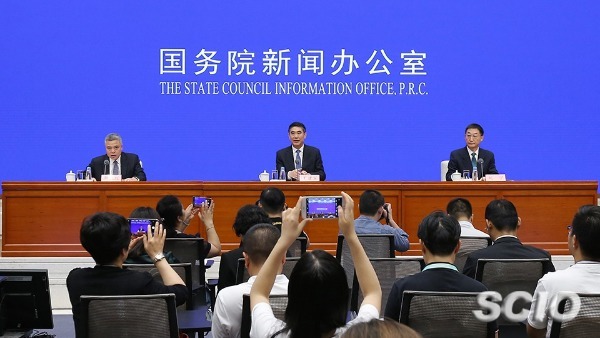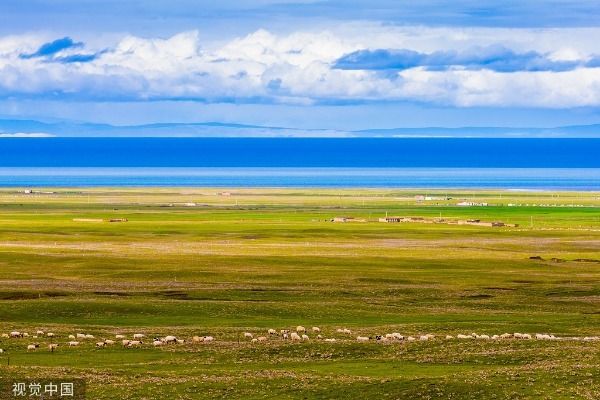Qinghai: 70 years on

Editor’s Note: Starting in May, the State Council Information Office has been organizing news conferences for each province, autonomous region and municipality to give briefings about their social and economic development since the founding of New China 70 years ago.

During the Qinghai session held Sept 4 in Beijing, Wang Jianjun (center), secretary of the CPC Qinghai Provincial Committee, and Liu Ning (right), governor of Qinghai Provincial People's Government, detail the province’s achievements over the past 70 years and answer reporters’ questions during the news conference. [Photo/scio.gov.cn]
Economic Growth
Qinghai has undergone earth-shaking changes over the past 70 years. Regional GDP has increased 335-fold compared with that of 1949, and the revenue of the fiscal budget has surged 6,821 times compared to 1951. From 2013 to 2018, the average annual growth of number of tourists visiting Qinghai was 17.7 percent, and tourism revenue increased by 24.7 percent.
Livelihood Improvement
The per capita disposable incomes of urban and rural residents have increased by 158 times and 91 times compared with that of 1978. The compulsory education consolidation rate has reached 96.9 percent and average life expectancy is 72.05.
A three-dimensional transport network with airports, high-speed railways and expressways has been formed in Qinghai. By the end of 2018, the mileage of highways was 82,137 kilometers, 174 times that of 1949. The road network density was 11.4 km per 100 square km. All cities have been connected with freeways, all county-level administrative districts have been linked by secondary roads, and 98.6 percent of villages and towns and all administrative villages have access to roads.
Green Development
Qinghai is building two pilot national parks: the 123,100-sq km Sanjiangyuan National Park, which is more than seven times the size of Beijing, and the Qilian Mountain National Park. Meanwhile, it is actively implementing the concepts of ecological priority and green development, and vigorously boosting the development of green energy, green industry, green consumption and green organic farming.
The clean energy installed capacity in Qinghai has exceeded 12 million kilowatts. A power line to transfer clean energy from Qinghai to Zhumadian in Henan province, will come into use in 2020. The province set a record in June this year, when for 360 consecutive hours its 6 million residents used nothing but clean energy generated from wind, solar and hydropower stations. In terms of green industry, Qinghai promotes a circular economy and a digital economy. The output value of the circular economy now accounts for more than 60 percent of the overall economy. As to green organic farming, together with the Ministry of Agriculture and Rural Affairs it has built the nation’s first demonstration province for green organic agricultural and livestock products, and reduced the use of chemical fertilizers and pesticides by 24.4 percent.
Fighting Poverty
From 2013 to 2018, Qinghai lifted over 1.08 million people out of poverty and the poverty rate in rural areas dropped from 24.6 percent to 2.5 percent. The province has lifted 60 percent of poor counties, 90 percent of poor villages, and 85 percent of poor people out of poverty.
Qinghai has adopted various means to fight poverty. First, the province encouraged the development of ramen cooking and embroidery industries. It now has nearly 200,000 people working in 27,200 ramen restaurants across the country and their annual output is 15 billion yuan ($2.14 billion). Second, the province offered 126,000 positions as "ecological conservators" to the poor, and the average annual income of each household increased by 21,600 yuan. Third, it relocated nearly 120,000 poor people who had been living in poor conditions. The fourth method is education. Qinghai implemented a 15-year education funding policy for students in Tibetan-inhabited areas. Fifth, the self-funded ratio of poor people’s inpatient expenses has been reduced to below 10 percent.

Qinghai (green ocean), high up on the plateau next to Tibet at an average altitude of 4,058 meters, is an important ecological buffer zone and a frontier in wild life protection. The province is home to many species, including the Tibetan antelope. [Photo/VCG]
MOST POPULAR
- 1 China to continue opening up its mega-market to world: premier
- 2 Policies concerning expats, foreign enterprises in November 2025
- 3 China to enhance convenience for inbound tourism: minister
- 4 Departure tax refund applications surge 285% as inbound tourism rebounds
- 5 China's foreign trade up 3.6% in first 11 months of 2025







